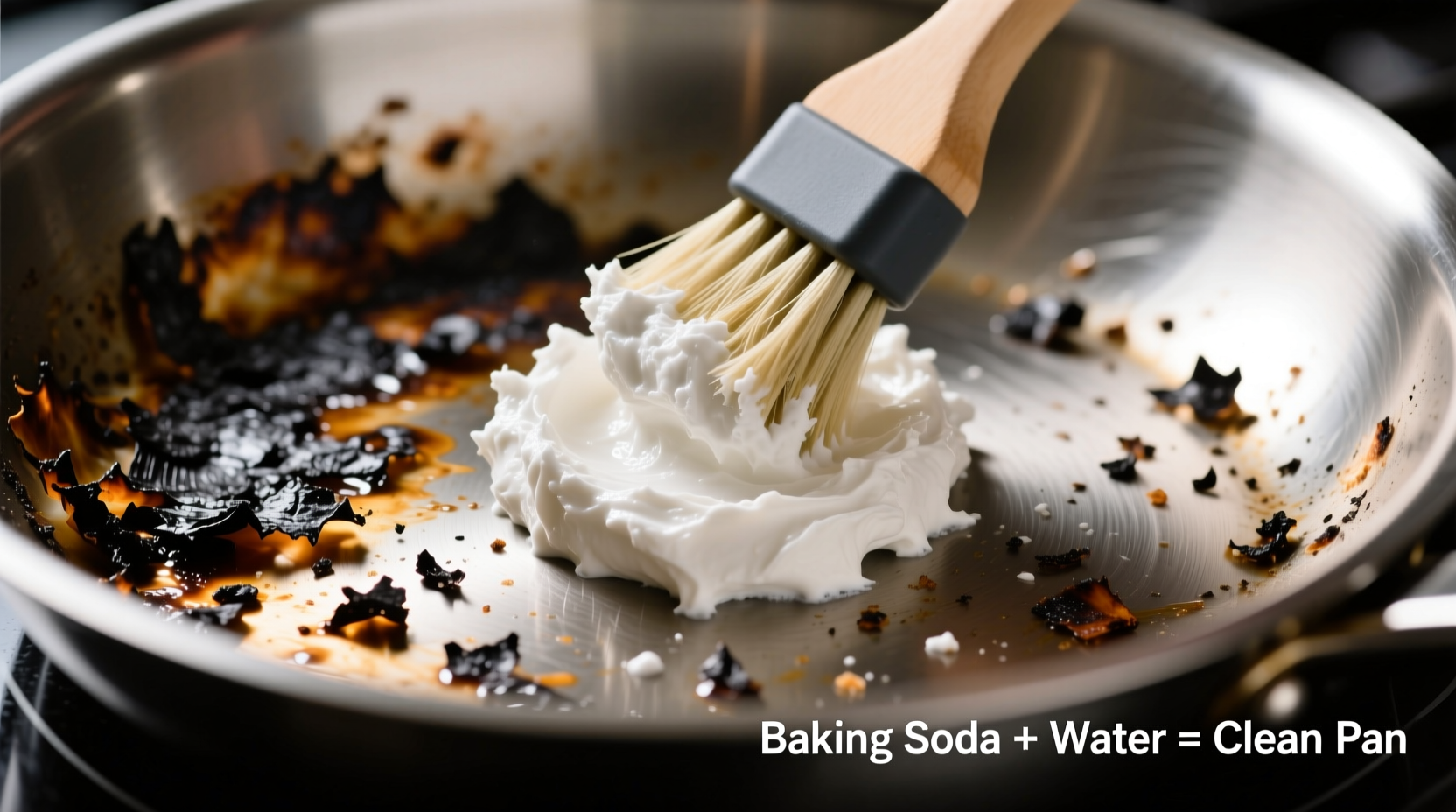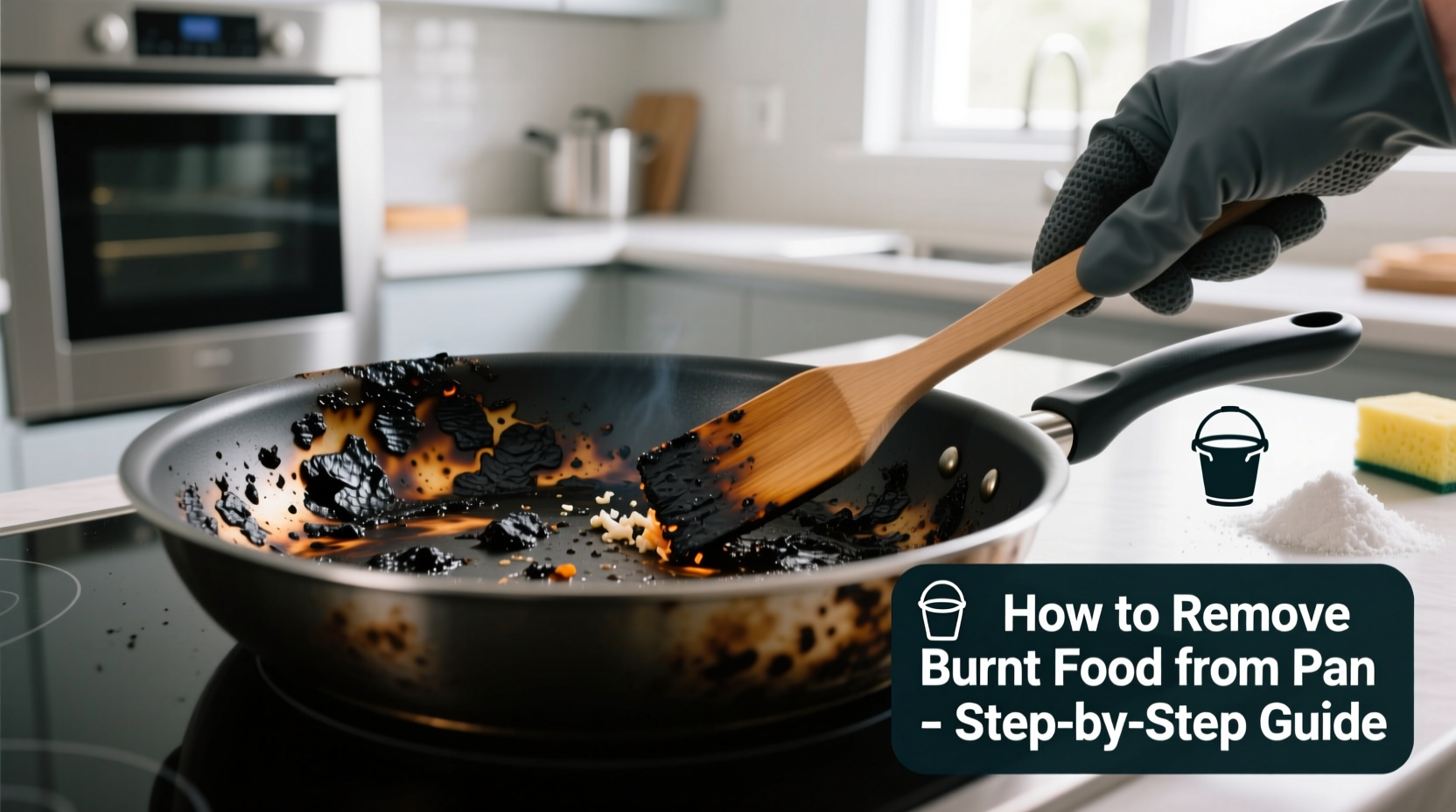Immediate Action: What to Do Right After Burning Food
Timing matters when dealing with burnt food. If you catch it early, you can prevent permanent damage to your pan. Never pour cold water into a scorching hot pan—that causes thermal shock that can warp metal. Instead:
- Turn off heat immediately and let the pan cool slightly (2-3 minutes)
- Add warm water to cover the burnt area while the pan is still warm (not hot)
- Let it soak for 10-15 minutes to loosen carbonized food particles
This simple step prevents the burnt material from bonding permanently with your cookware surface. Professional chefs at the Culinary Institute of America recommend this immediate soaking technique as the first line of defense against stubborn burns (Culinary Institute of America, 2023).
7 Effective Methods for Removing Burnt Food (By Pan Type)
| Method | Best For | Time Required | Effectiveness |
|---|---|---|---|
| Baking soda paste | All pans except non-stick | 15-30 minutes | ★★★★☆ |
| Vinegar soak | Stainless steel, cast iron | 30-60 minutes | ★★★★☆ |
| Salt scrub | Copper, cast iron | 10-20 minutes | ★★★☆☆ |
| Dish soap + baking soda | Non-stick surfaces | 20-40 minutes | ★★★☆☆ |
1. The Baking Soda Power Paste (Most Versatile Method)
For stainless steel, cast iron, or copper pans:
- Mix 3 tablespoons baking soda with 1 tablespoon water to form a thick paste
- Apply paste to burnt areas, covering completely
- Let sit for 15-20 minutes (longer for severe burns)
- Gently scrub with nylon brush or non-abrasive sponge
- Rinse thoroughly and repeat if necessary
This method works through a chemical reaction where baking soda's alkaline properties break down the carbonized food molecules. The University of Illinois Food Science Department confirms baking soda's effectiveness in breaking molecular bonds in burnt food residues (University of Illinois, 2022).

2. Vinegar Soak Method (For Tough Stainless Steel Burns)
When baking soda alone isn't enough:
- Fill the pan with equal parts white vinegar and water (enough to cover burnt area)
- Bring to a gentle simmer (do not boil vigorously)
- Maintain simmer for 5-10 minutes
- Turn off heat and let cool slightly
- Add 2 tablespoons baking soda (creates a fizzing reaction)
- Let sit for 15 more minutes before scrubbing
The acetic acid in vinegar helps dissolve mineral deposits while the baking soda creates a mild abrasive action. This combination effectively removes the most stubborn carbonized residues without damaging cookware surfaces.
3. Salt-and-Oil Scrub (For Cast Iron Preservation)
Cast iron requires special care to maintain seasoning:
- While pan is still warm (not hot), sprinkle coarse salt generously over burnt area
- Add 1-2 tablespoons of cooking oil (vegetable or flaxseed)
- Use a folded paper towel or non-metal scrubber to rub the salt mixture
- Focus on burnt spots using circular motions
- Rinse with hot water (no soap) and dry immediately
- Apply thin layer of oil to re-season
America's Test Kitchen research shows this method removes burnt food while preserving the polymerized oil layer that makes cast iron non-stick (America's Test Kitchen, 2024). Never use vinegar on cast iron as it strips the seasoning.
Avoid These Common Mistakes
Many home cooks worsen the problem with these approaches:
- Metal scrubbers on non-stick pans - permanently damages the coating
- Excessive soaking of cast iron - causes rust and seasoning loss
- Using oven cleaner - contains harsh chemicals that can leach into future cooking
- Scrubbing while pan is extremely hot - creates steam burns and warps metal
Preventing Future Burnt Food Disasters
Professional chefs prevent burnt food through these techniques:
- Use proper heat levels - most cooking happens at medium heat, not high
- Preheat pans properly - test with water droplets (should sizzle gently)
- Choose appropriate cookware - stainless steel for high-heat searing, non-stick for delicate foods
- Never leave cooking unattended - especially when using high heat
According to a 2023 survey by the National Kitchen and Bath Association, 78% of burnt food incidents occur when cooks leave the stove unattended for more than 2 minutes. Setting a timer even for short cooking intervals dramatically reduces burnt food occurrences.
When to Replace vs. Repair Your Pan
Some damage is beyond repair. Replace your pan if:
- Burnt areas have created permanent pits in the metal surface
- Non-stick coating is visibly flaking or peeling
- Cast iron has deep cracks or significant rust spots
- Stainless steel shows rainbow discoloration (sign of overheating)
For most burnt food situations, however, proper cleaning techniques will restore your cookware to excellent condition. The key is addressing the problem promptly with the right method for your specific pan type.











 浙公网安备
33010002000092号
浙公网安备
33010002000092号 浙B2-20120091-4
浙B2-20120091-4